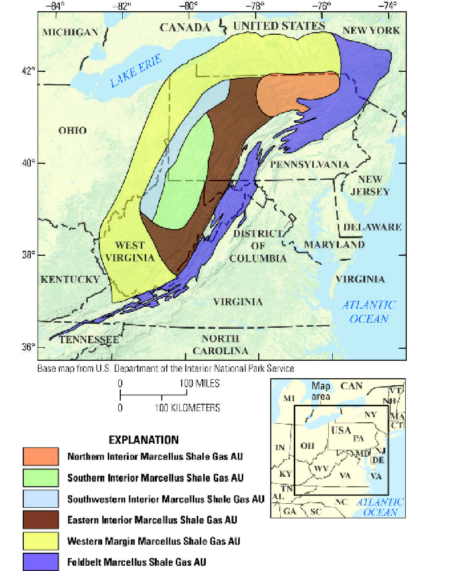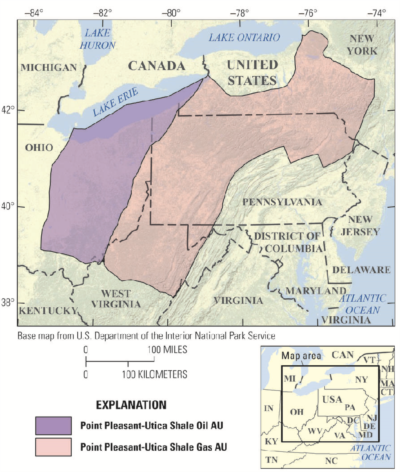The Marcellus Shale and Point Pleasant-Utica Shale formations of the Appalachian Basin contain an estimated mean of 214 trillion cubic feet of undiscovered, technically recoverable continuous resources of natural gas, according to new USGS assessments.

The assessment unit map for the Marcellus Shale within the Appalachian Basin. Although it occupies similar areas as the Point Pleasant-Utica Shale, the Marcellus is much younger, having formed in the Devonian age.
The Marcellus, Point Pleasant and Utica are extensive formations that cover parts of Kentucky, Maryland, New York, Ohio, Pennsylvania, Virginia and West Virginia.
This is a significant increase from the previous USGS assessments of both formations. In 2011, the USGS estimated a mean of 84 trillion cubic feet of natural gas in the Marcellus Shale, and in 2012 the USGS estimated about 38 trillion cubic feet of natural gas in the Utica Shale.
Significant amounts of natural gas have been produced from the Marcellus and Utica Shales since the previous USGS assessments. USGS assessments are for remaining resources and exclude known and produced oil and gas.

A drill rig at a well site in the Marcellus Shale gas play of southwestern Pennsylvania.
The natural gas in these formations is classified as continuous, because it is spread throughout the assessed rock layers instead of being concentrated in discrete accumulations. Production techniques like directional drilling and hydraulic fracturing are required to produce these resources.
“Since our assessments in 2011 and 2012, industry has improved upon their development techniques for continuous resources like the shale gas in the Appalachian Basin,” said Walter Guidroz, program coordinator for the USGS Energy Resources Program. “That technological advancement, plus all of the geological information we’ve gained from the last several years of production, have allowed us to greatly expand our understanding of these formations.”
The Marcellus Shale also contains an estimated 1.5 billion barrels of natural gas liquids, while the Point Pleasant-Utica Shale also contains an estimated 1.8 billion barrels of oil and 985 million barrels of natural gas liquids. Natural gas liquids are liquid hydrocarbons like propane, butane and/or ethane.

The assessments units of the Point Pleasant-Utica Shale Formation within the Appalachian Basin. Although it occupies similar areas as the Marcellus Shale, it was formed during the Ordovician Period, millions of years prior to the Marcellus.
These assessments are for undiscovered, technically recoverable resources. Undiscovered resources are those that have been estimated to exist based on geology and other data, but have not yet been proven to exist by drilling or other means. Technically recoverable resources, meanwhile, are those that can be produced using today’s standard industry practices and technology. This is different from reserves, which are those quantities of oil and gas that are currently profitable to produce.
USGS is the only provider of publicly available estimates of undiscovered technically recoverable oil and gas resources of onshore lands and offshore state waters. The USGS Marcellus and Point Pleasant-Utica Shale assessments were undertaken as part of a nationwide project assessing domestic petroleum basins using standardized methodology and protocol.
The new assessment of the Marcellus Shale can be accessed here. The new assessment of the Point Pleasant-Utica Shale may be found here.
Energy Industry Directory: USGS
 KEYFACT Energy
KEYFACT Energy